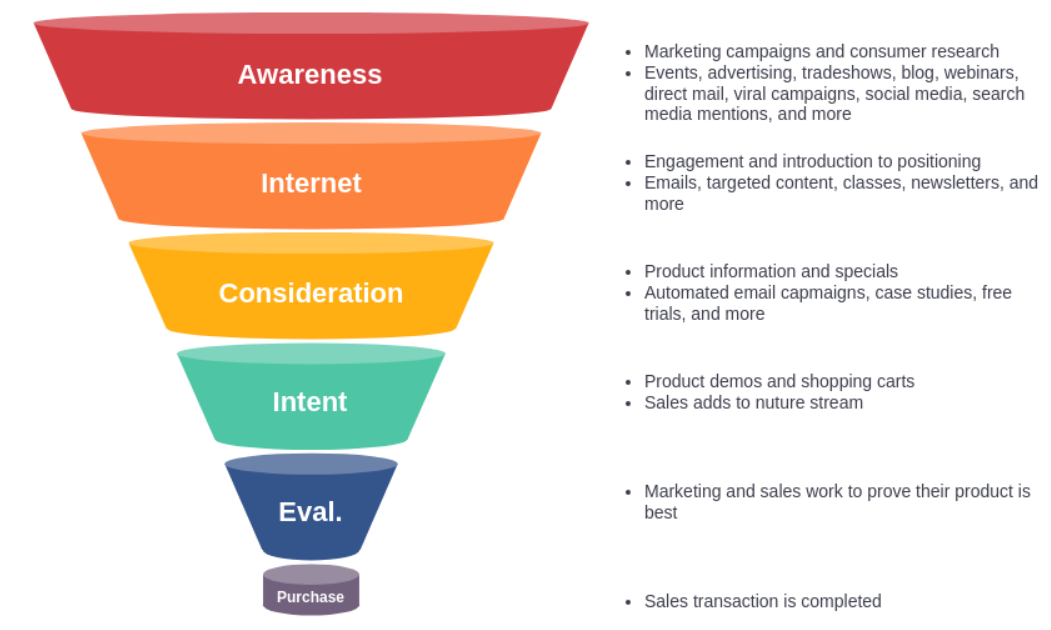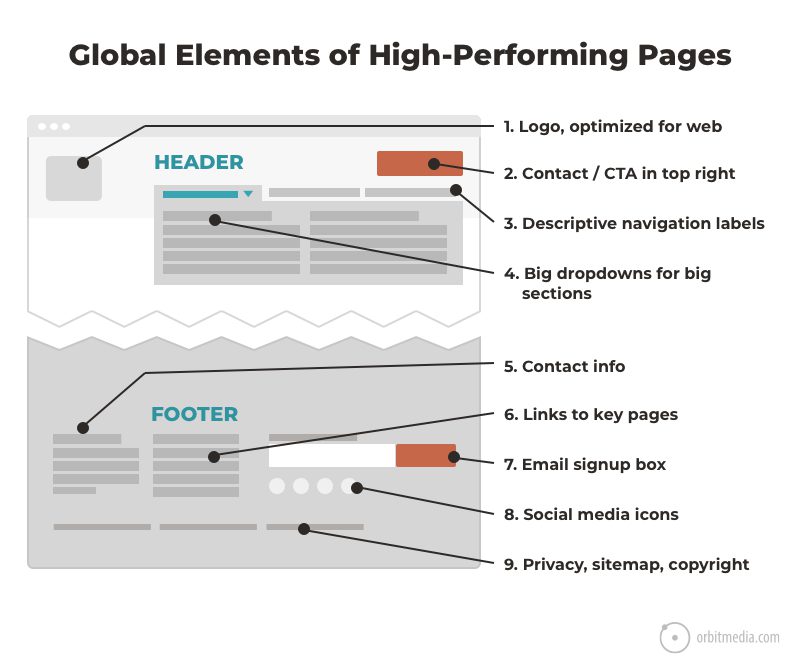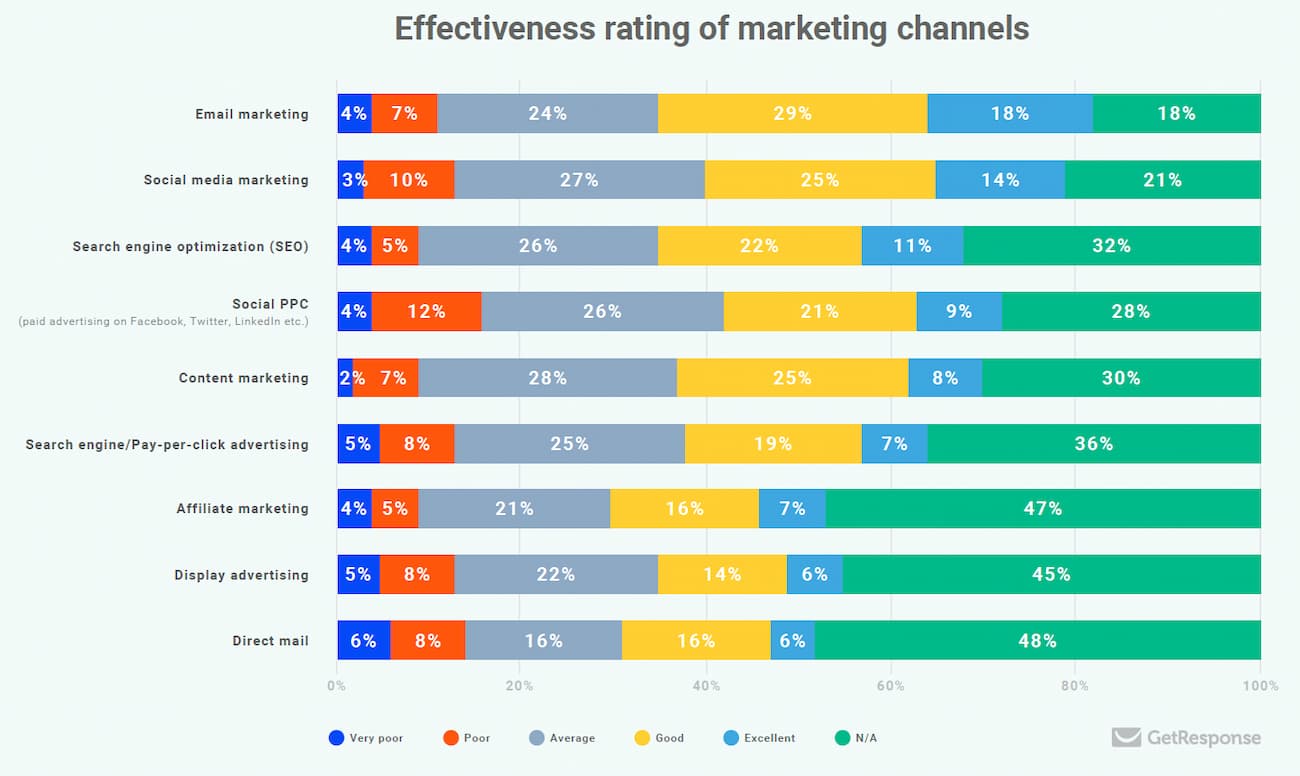
Even though your strategy is working and your metrics are strong, your e-commerce is still not growing as quickly as you would like.
Just like weight, stamina is a factor in speed. You might need to let go of some of the moorings in order to allow your ecommerce expand more quickly.
Why does that matter?
This entails automating any area of your e-commerce company that has an impact on both your business operations and the experience of your clients. You might achieve speedier outcomes by reducing the effort, the stress, and the additional expenses.
Automation is certainly applicable to accounting, production operations, and HR procedures. And yes, everything affects the customer experience in a business, but for now, let’s focus on these top three: Marketing Automation, Data Collection Automation, and Shipping & Fulfillment Automation.
But before we get started, there are two crucial measures you need to think about that could pave the way for efficient automation.
Step 1. Look inside
The type of ecommerce software you run your business on has a first-hand impact on the automations you can access. Let’s look at the top 3 platforms, according to Techradar, and see what type of integrations they have to offer.
Wix has 250+ apps in its marketplace, ranging from CRM tools to Payment and Shipping.
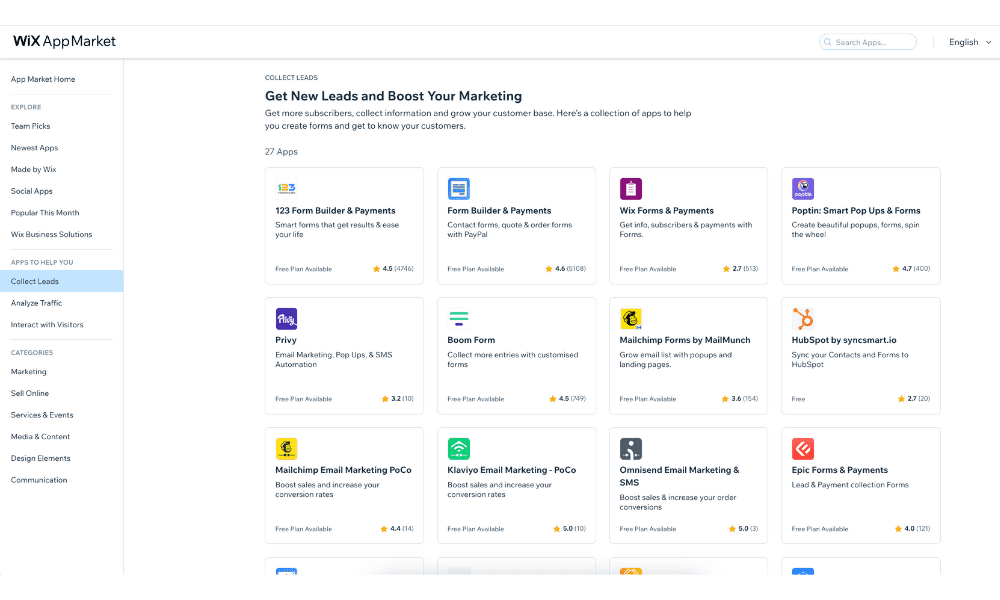
WooCommerce has over 700 extensions grouped into ten categories, so you can easily choose the ones that interest you most.
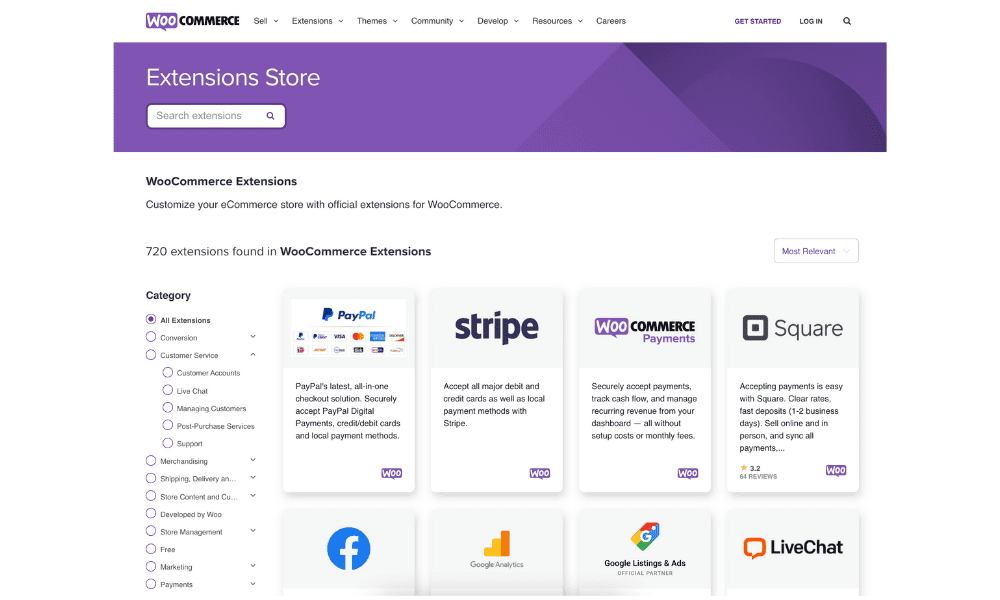
Shopify is one of the most generous ecommerce platforms with their integrations offering. With 6800+ apps in its store, there’s a lot you can cover.
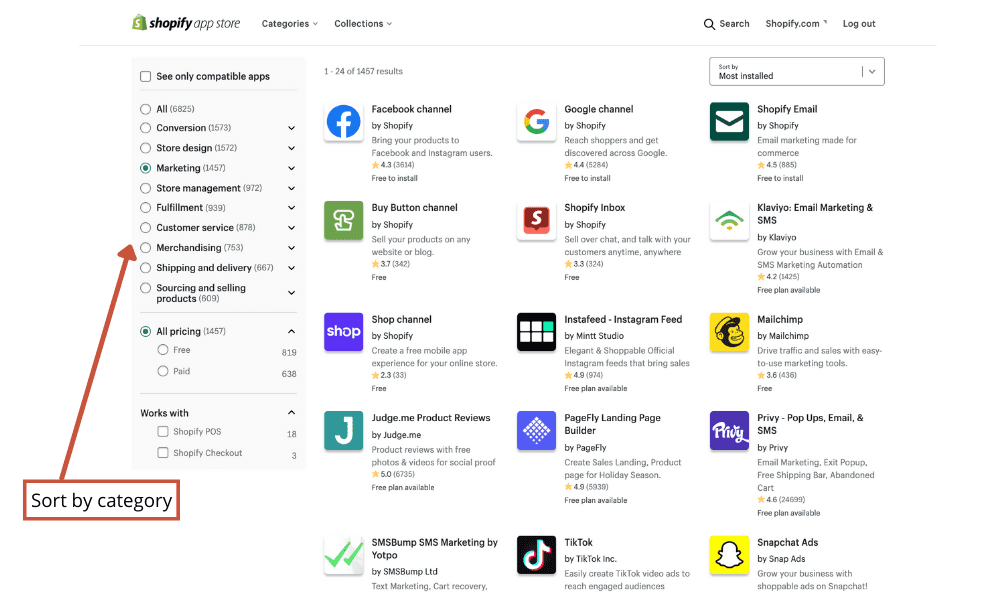
Whether you’re already using one of these platforms or looking to switch to a new one, scan their app marketplace. It gives you a good understanding of possible automations.
Step 2. Look outside
The ecommerce industry has 7.9 million online retailers, out of which 2.1 million are in the United States. And that’s only B2C companies. It’s a competitive market that continues to grow while being the constant target of innovations.
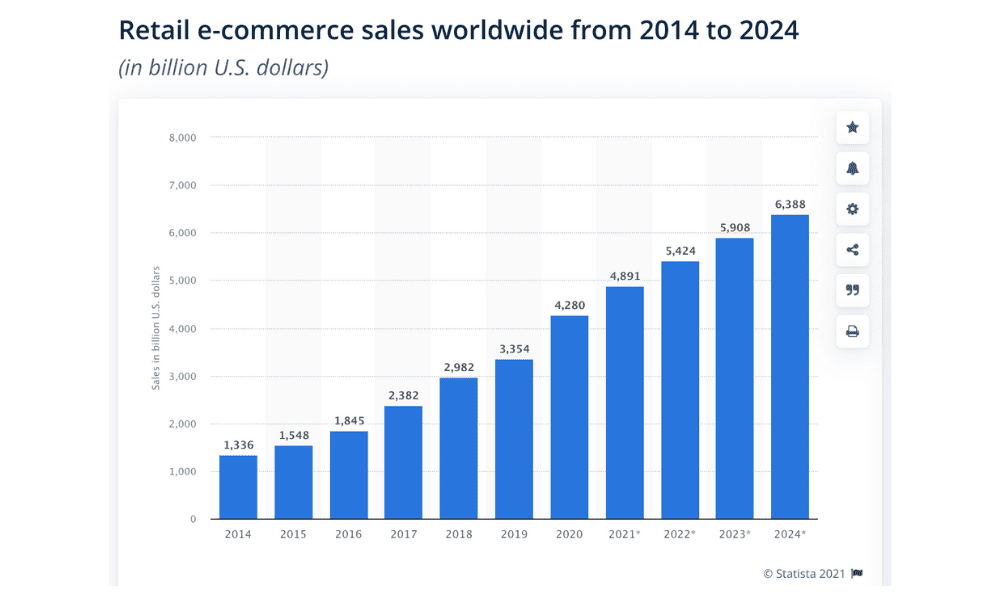
Source: Statista
So, keeping an eye on the industry trends and the market evolution can help you decide which automations you could consider prioritizing at some point.
Let’s say you want to expand to a new market next year. You want to start shipping to Europe. You might need a whole new set of automated workflows that are GDPR compliant or make shipping easy and fast on the European continent.
After you correlate Step 1 with Step 2, it should be easier for you to decide on the automations that make the most sense to your ecommerce.
Now let’s explore the three main ways to automate your ecommerce for fast growth.
Marketing automation
Consumers shop in a messy way. Even if you have a well-defined buyer’s journey, they still don’t go from point A to point B in a straight line. You might attract them on Facebook, but make the sale through email a month later.
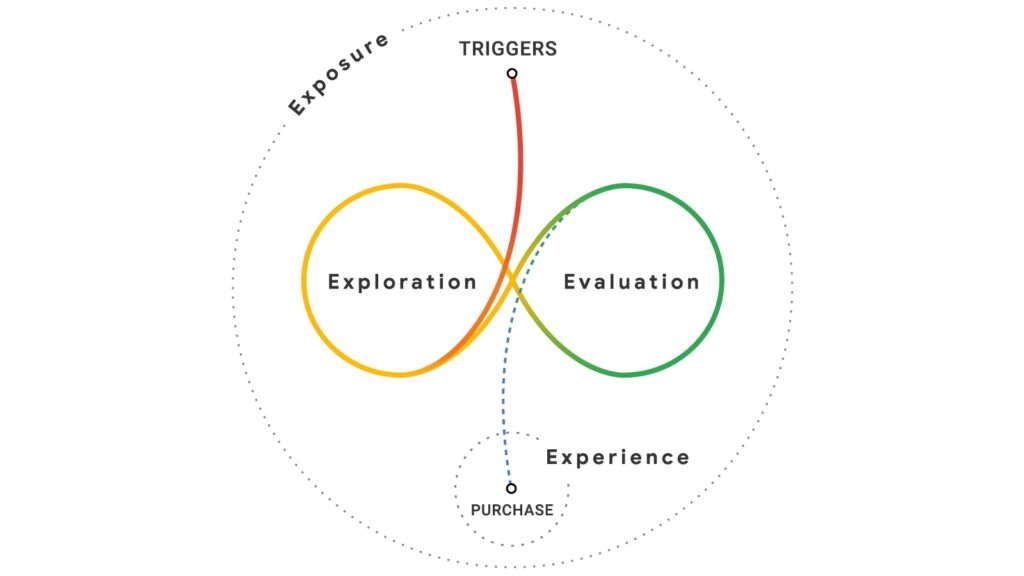
Source: Think with Google
So your ecommerce business needs to be everywhere. And you might find it challenging to embrace multiple channels if you do things manually.
But marketing automation has proven to be successful in this area. About 63% of companies that use marketing automation are outgrowing their competitors. And it leads them to an average of 14.5% increase in sales productivity and a 12.2% cut in marketing expenses.
Marketers say that email marketing, social media, and analytics are some of the top areas to automate workflows.
Email marketing
Email marketing automation implies sending predefined emails to your target audience based on a trigger (e.g.: purchase, click) or event (e.g.: birthday). An automated email flow is different from a newsletter or a campaign because you set it up just once, and it’s automatically launched every time the trigger sets off.
You can also personalize the flow based on your customer’s action, but usually, you build it to address a specific group.
Out of various digital channels, email marketing is proving to be the most effective for ROI.

Source: GetResponse
How to use email marketing automation?
- Welcome new subscribers – tell subscribers what to expect from your emails, share the brand’s story, invite them to follow you, and surprise them with an exclusive offer.
- Create a post-purchase flow – thank customers for their purchase, keep them updated with the status of their order, give product tips & tricks, ask for a review.
- Address payment failure situations – inform customers of the payment status, give reminders, offer your help or step-by-step instructions in case of payment issues.
To set up your email flows, you need an email service provider, like MailChimp, Lemlist, or Sendinblue.
As an example, this is how a flow looks in Klaviy:
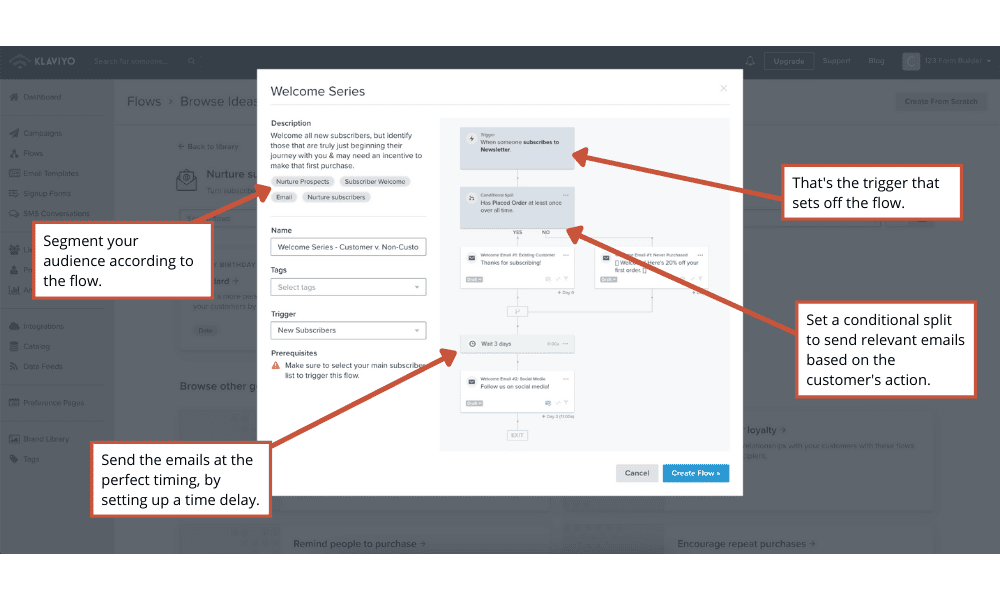
Email service providers usually integrate with the majority of ecommerce software providers, so it should be easy to align them. If they don’t, you can use integration software such as Zapier or Alloy to connect your platforms.
Research tells us that 58 percent of people stop doing business with a company because of poor customer experience. Creating automated emails gives you just the right opportunity to keep your customers engaged through proper communication. It will also prove to be effective in nurturing leads and moving them through the sales funnel.
Social Media
With over 4.48 billion people using social media, ecommerce businesses have in their hands a great point of connection with their target audience. And we know that a user goes on 6.6 social media platforms monthly.
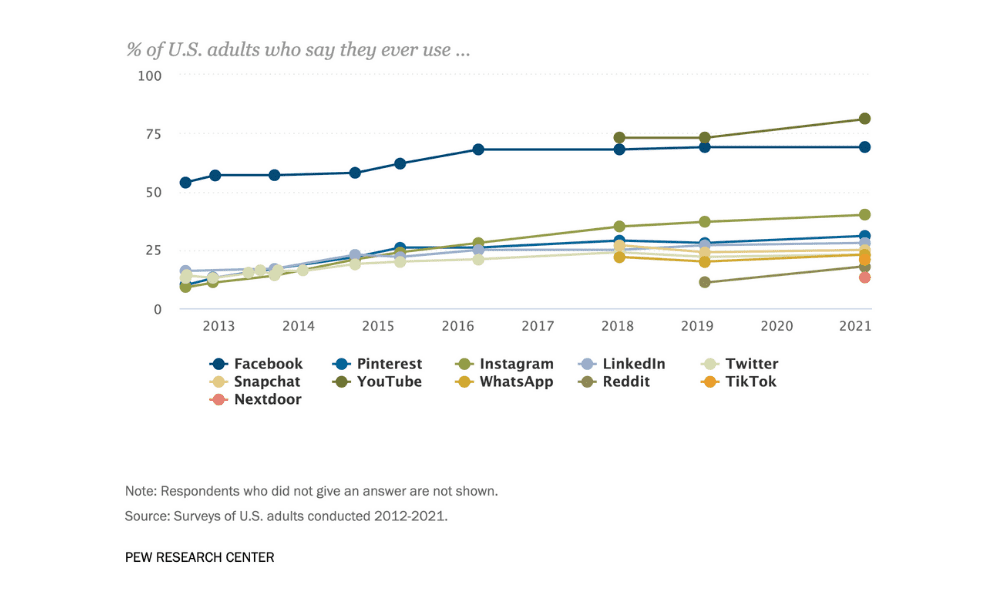
Source: Pew Research Center
But we can all agree that managing six social media accounts can be pretty overwhelming and time-consuming. Posting content, keeping up with new trends, diving deep into the analytics – there’s only so much a person can do.
Speed and originality are two key factors in having a successful social media presence. But unfortunately, more often than not, they’re mutually exclusive.
That’s why we’ll take speed under the wings of social media automation.
By saving time on those repetitive tasks, you’ll have more of it to engage in spontaneous conversations with followers and keep your online presence exciting and authentic.
So what exactly can you automate?
Multiple social media automation tools can help you take the weight off your shoulders from research to posting. Here are two examples:
Chatbots
You can tap into the advantages of conversational marketing using chatbots. By automating the 1:1 conversations with your customers, you make yourself available to them 24/7.
Use their most common questions to create predefined answers that offer the support they expect from an online business. It is exactly what they want, your undivided attention.
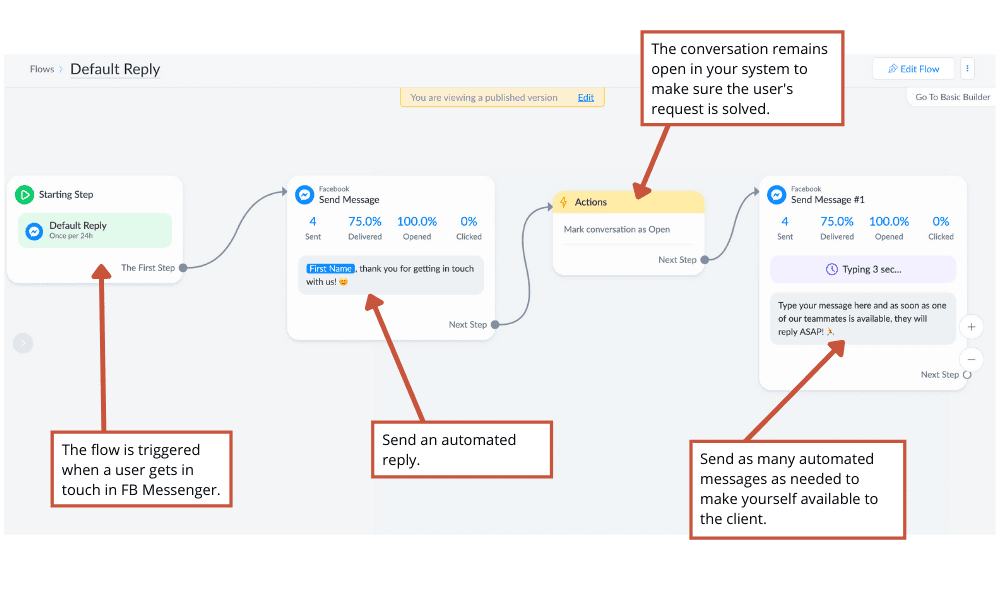
Scheduling
All of us consume LinkedIn content in a completely different way than we do with Instagram. Each social media channel triggers a particular user behavior. That requires efficient scheduling, so your social media content reaches your audience at the right moment in the expected form. There are many great scheduling tools available that can help you plan your posts and schedule them ahead of time, so you can smoothly integrate social media into your marketing campaigns.
The chatbots and scheduling examples make only the tip of the iceberg to help you get your head in the game. If these ideas have sparked your interest, you can take a look at this comprehensive guide on how to automate social media marketing.
Analytics & Reporting
You might have your marketing data in silos. There’s a little bit of everything in Google Analytics, Salesforce, Facebook Ads, Linkedin, Mailchimp, and so on.
But you want to have a complete overview of all key metrics across all your channels at any moment in time. However, manually capturing all this data can be a time-consuming task. Automating this process can speed it up and help you keep track of your performance in a more agile way.
A marketing analytics and business intelligence (BI) software can give your marketing tools a common ground. It’s a platform that connects your apps, extracts the data you want to track, and gives you dynamic visualization capabilities, aka dashboards or interactive reports.
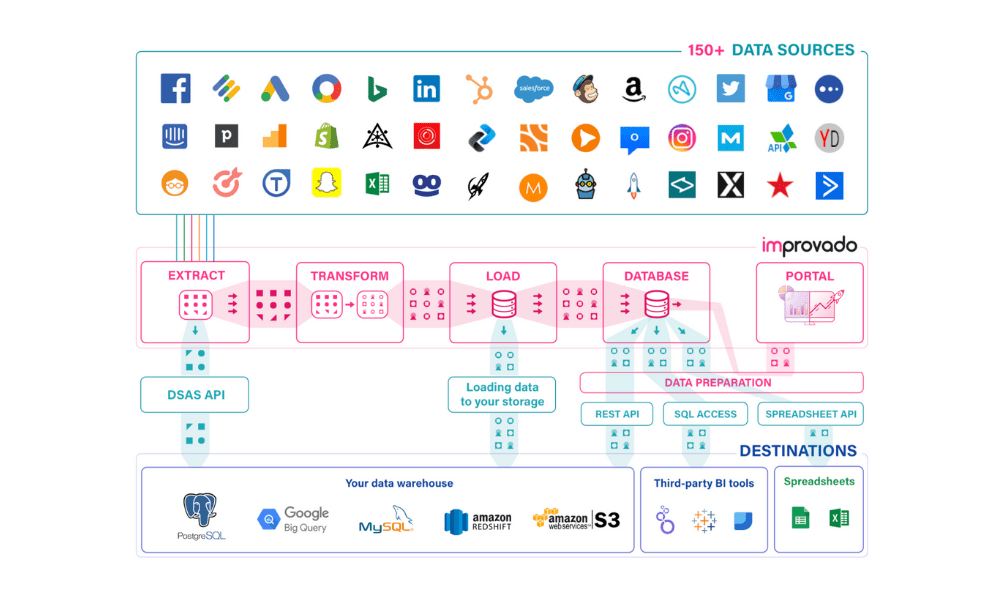
Source: Improvado
It might be costly to use marketing analytics software, yet it’s one of the main ways to increase your empathy towards your customers. You learn about their every step, start to recognize when they have doubts, where they take a step back, or at what point in their journey they search for more info.
And shortly you might find yourself asking more and more: “ What can I do to help my customer?”. As marketers, we all strive to keep our customers close. Because there’s no doubt that customer loyalty pays off.
So the numbers you get every month should tell you a story about how your customers interact with your ecommerce business. It’s hard to track the customer journey from their first visit on the website through sign-up and eventually a purchase if you don’t connect these metrics.
A dashboard can help you visualize this journey and spot specific patterns, hiccups, or tactics that work best.
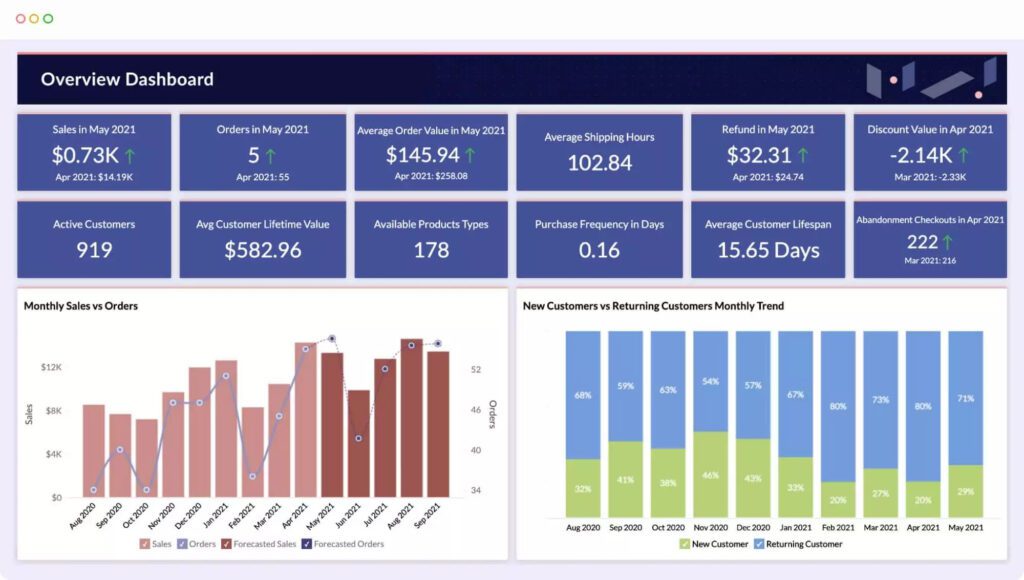
Source: Zoho
Another way to get started with marketing analytics automation is to approach it gradually. If your goal is to ace your social media presence or have more clarity on the marketing attribution model, automate just those bits of analytics.
A marketing analytics report is not an endpoint; it’s only the beginning of the conversation around the success and challenges of your business.
It’s meant to take the uncertainty out of decision-making and help you recognize the next successful step.
Data collection
Data-driven marketing is something that 76% of marketers already do. In the top three of their objectives, we find increasing customer loyalty, boosting conversion rate, and optimizing the customer journey.
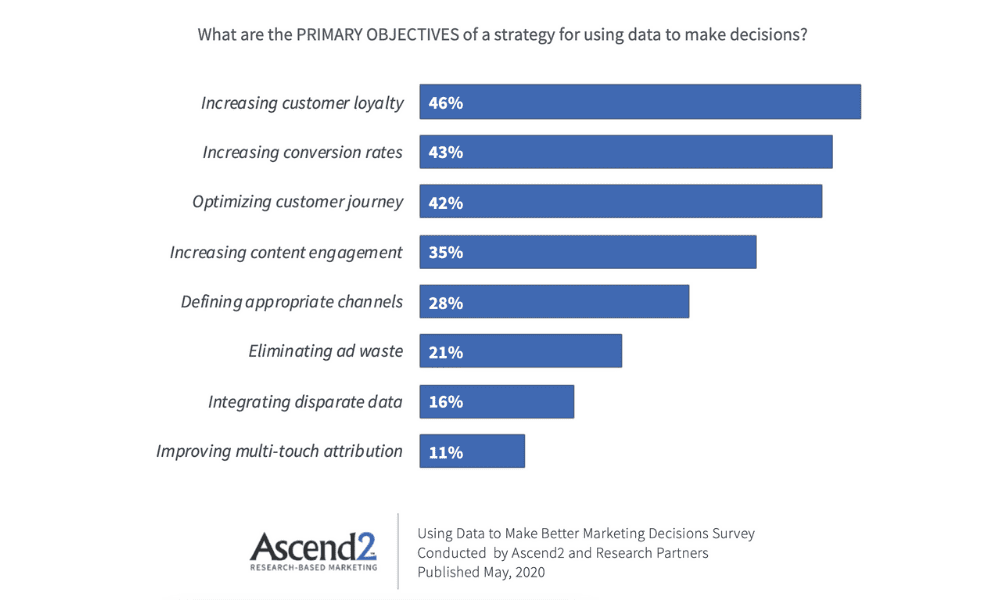
Source: Ascend2
If collected systematically and adequately, data can give you an accurate picture of how your ecommerce business is doing.
Whether it’s customer feedback, click-through rate (CTR), or the number of product returns, you can collect data at any point in the customer journey.
But that is both a blessing and a curse. Because while you’re collecting a lot of valuable data, it also implies juggling a lot of balls.
Automating data collection comes with countless benefits. It cuts down the number of human errors, increases efficiency, reduces the paperwork and the costs related to it, and contributes to a seamless customer experience.
But where to start with data collection automation? We’ll go into three main areas that ecommerce businesses find relevant.
Collecting customer data
Your ecommerce solves a problem your customers have: a skin problem, a heating problem, a comfort problem. Knowing your customers makes it easier for you to speak their language and help solve their issues with your product.
So what do you do to get to know them? You ask them about themselves and what interests them. And that’s when you start collecting data.
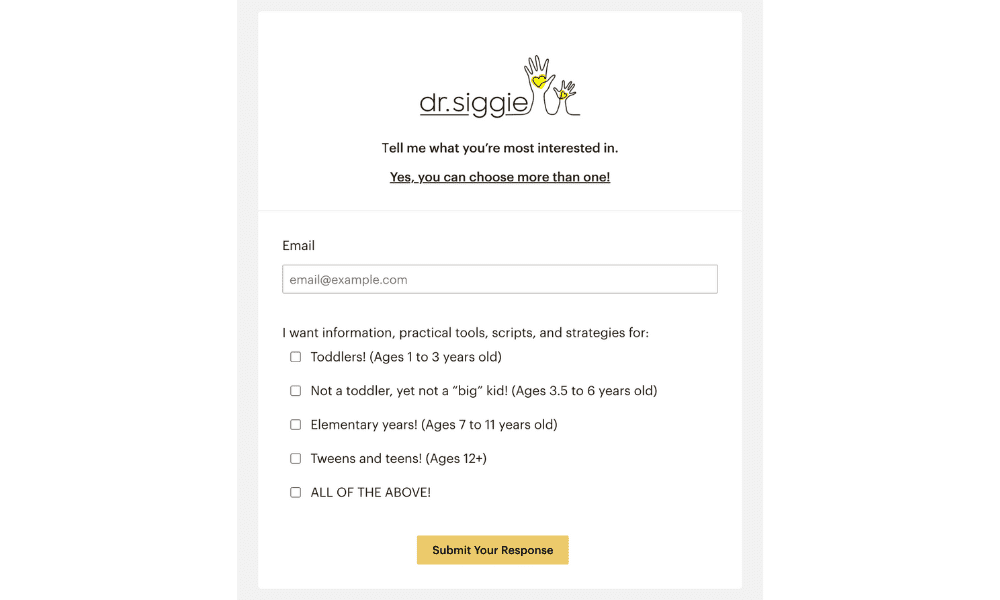
For starters, use a form builder that you can easily personalize and connect to your already existing tools. Allow your data to travel across your apps to have a bird’ eye view of your customers.
You want your customers to feel heard and valued. So asking them about their preferences or the industry they work in will help you create relevant content and personalize their experience.
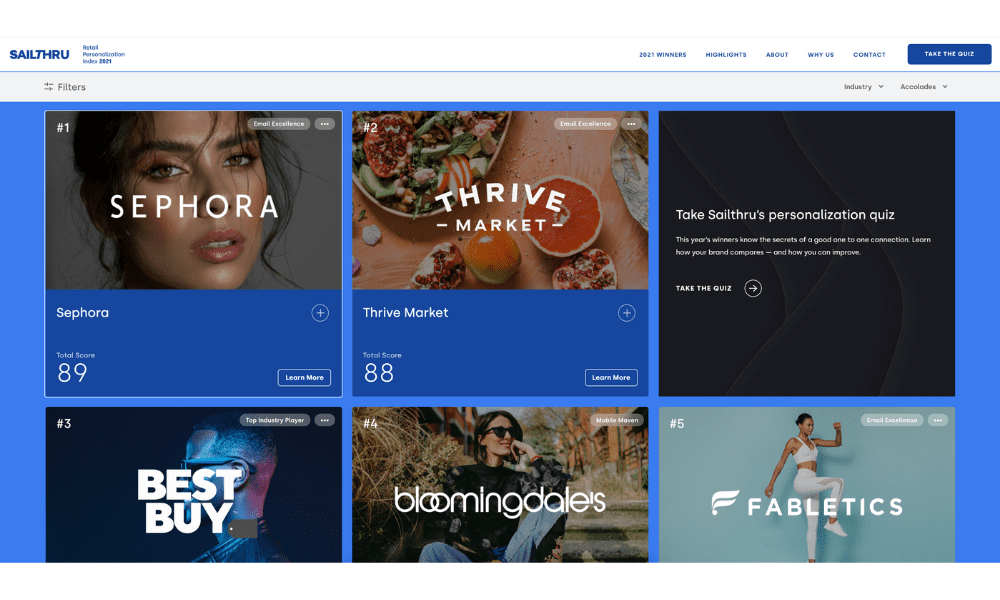
Source: Sailthru
Collecting customer feedback
Nine out of ten business leaders say that customer preferences are moving faster than ever before. Keeping your business aligned to what your customers want means having their constant input.
That might seem hard to do if you plan to hand customers paper surveys after they visit your shop. Or if you assigned a customer care agent to write to every client personally and ask about their experience.
Here are three easy ways to put in place an automated customer feedback system.
1. Net Promoter Score (NPS)
NPS asks your customers to rate how likely they are to recommend your business to someone else.

The final score will give you an idea of how your clients feel about the brand due to their customer experience.
You can add the NPS anywhere: website, emails, texts, etc.
2. Real-time customer feedback
Let’s say a user visits your shop and keeps browsing but doesn’t add anything to the cart. You might want to find out why. You can set up a chatbot that asks them if there’s anything specific they’re searching for and need help with.
Or, upon exiting the website, you could have a widget popping out to find out why the user ended their journey. Will they be back? Is it because they didn’t find what they were looking for? Or maybe they need extra warming (a discount, a freebie, more info) before committing to you.
If they did buy your product and you want to know if they’re pleased with your shop, include an in-app survey or use Customer Satisfaction Score (CSAT) to learn about their overall buying experience. Asking for real-time feedback is valuable because it’s mostly uncensored, it’s warm and it’s honest.
With these insights, you can target your audience better, improve your product and address your customers’ objections.
3. Collecting social proof
Reviews and testimonials are some of the most effective ways to build trust with your audience. It adds credibility and shows how well your ecommerce walks the talk.
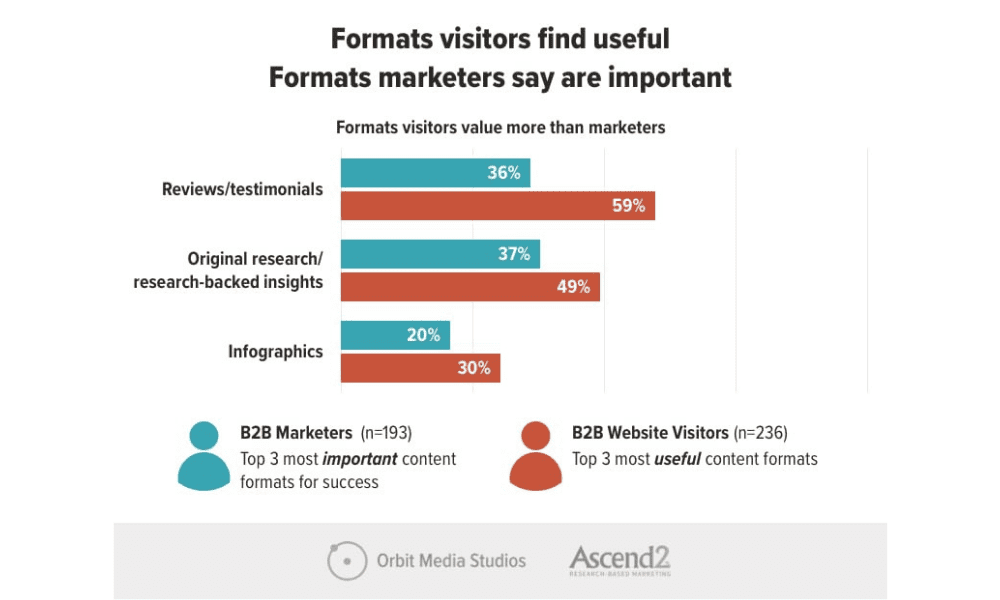
Source: Orbit Media Studios
But only about 50% of users leave a review monthly.
By automating the collection of social proof, you increase your chances of having your customers see your review request and respond to it. Especially if you “strike at the magic moment.”
What does that mean?
It means not waiting for the perfect moment but giving your customers the chance to leave their reviews across multiple channels at different times.
- Ask in one of your post-purchase email flows.
- Ask when you just signed the client.
- Ask on Facebook messenger through an automated message.
- Ask through 3rd party apps.
Make it easy and fast for customers to share testimonials.
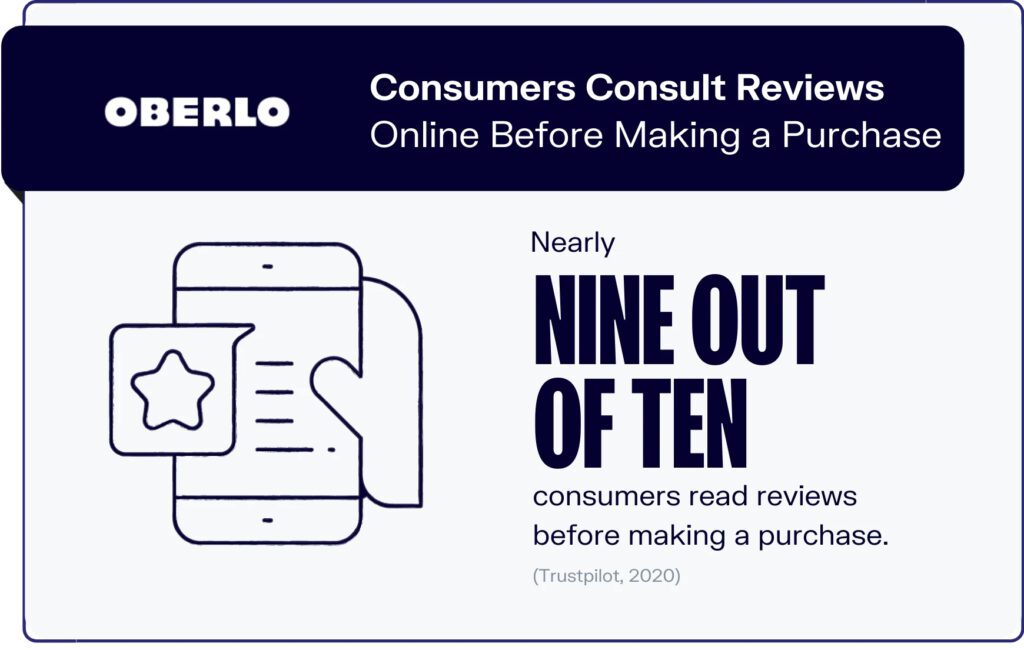
Source: Oberlo
And after you’ve collected a few, use these best practices on how to add social proof to your website.
You can even take it a step further. Analyze the reviews and use your customers’ language when you talk about your product. Address their uncertainties through valuable content. Speak their language.
Shipping & Fulfillment
Many businesses focus solely on automating their marketing operations to drive up conversion rates but fail to look at the ways to sustain the potential growth. If suddenly your orders jump up from 100 per month to 1000, that’s great. Kudos to your marketing team! But you also need to make sure that the fulfillment process is ready for this kind of expansion.
Three out of 10 reasons people buy online have to do with fulfillment.
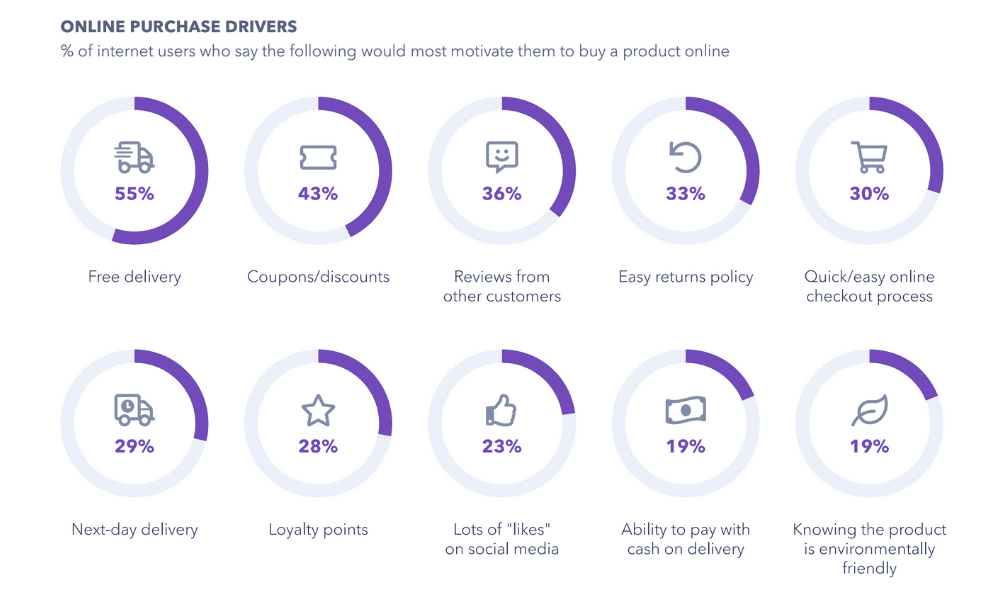
Source: GWI
And regardless of your distribution model, be it dropshipping, in-house, or through 3rd party logistics companies, you should strive to have a flawless fulfillment workflow. Why? Because companies that manage to have an order rate above 80% are more profitable than companies that have a rate below 60%.
And also because fast shipping, an easy delivery process, and ample product information have a big say in client satisfaction.
So what’s standing in the way of having a successful fulfillment process?
Human error.
It’s the number one reason why fulfillment often crumbles. And human errors are costly. So we turn to automation for answers.
Studies show that order process automation can help businesses reduce their costs by up to 15%.
Inventory management, warehouse operations, shipping & delivery, and returns are all parts of the fulfillment process that can and should be automated. It increases your company’s speed and keeps your customers…Uhm, fulfilled.
One of the most popular, although expensive, ways to automate your ecommerce fulfillment is working with a 3rd party logistics provider. Your logistics partner will usually cover everything from warehousing to order fulfillment.
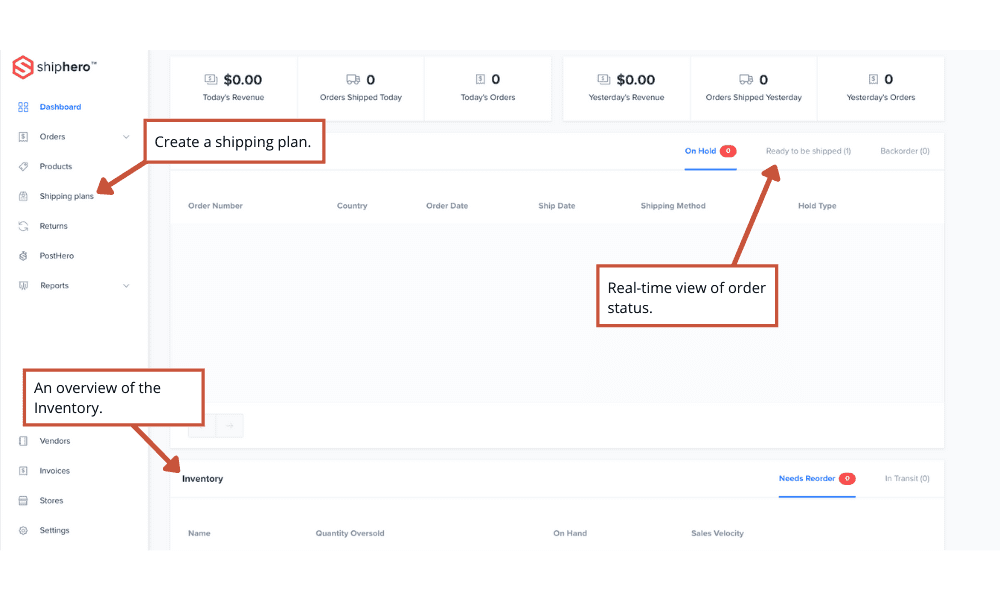
You can use separate automation software for each process, depending on your needs.
An automated order processing software can help you easily track orders, verify them, give order status updates and delivery estimates.
If you go a step further, you can integrate it with a warehouse management system. It would give you an accurate and real-time view of the stock availability while guaranteeing that the right product gets to the right customer.
Or, if you want to make easy returns a well-known advantage, you can use a return management system, like Happy Returns. It facilitates both physical and digital returns.
Fulfillment is one of those backstage processes that customers know very little about but can easily make or break a deal with them. And it should look easy to the customer.
With the right mindset and tools, your logistics can quickly become a huge competitive advantage for your ecommerce.
Automate the core areas of your business, and you’ll make more time to focus on the depth rather than the width of your ecommerce.
Article by Constanta Hornet of 123 Form Builder
